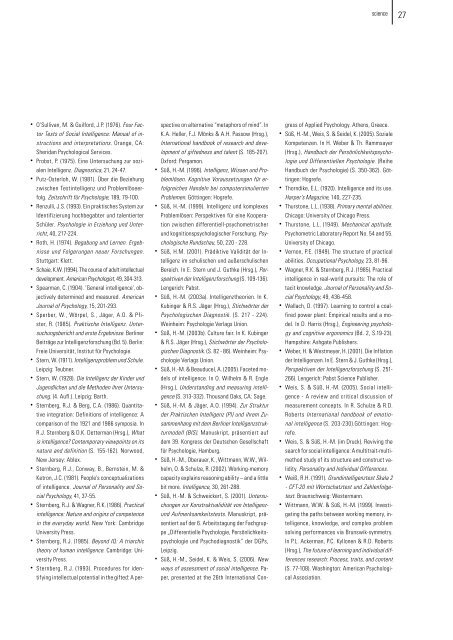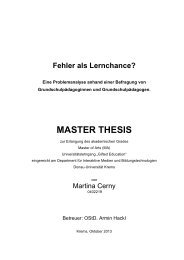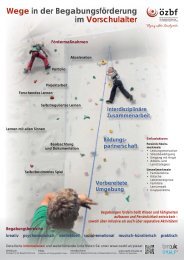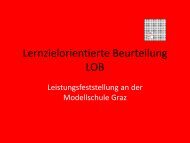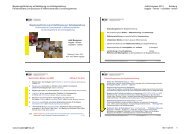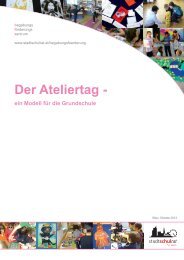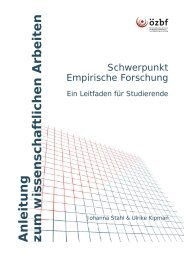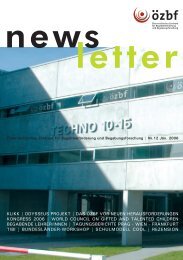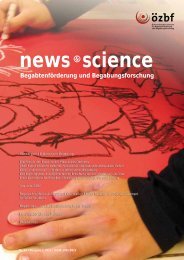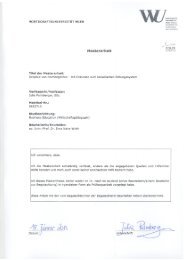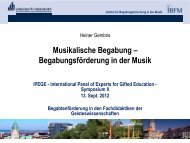news science - ÖZBF
news science - ÖZBF
news science - ÖZBF
Sie wollen auch ein ePaper? Erhöhen Sie die Reichweite Ihrer Titel.
YUMPU macht aus Druck-PDFs automatisch weboptimierte ePaper, die Google liebt.
<strong>science</strong><br />
27<br />
• O’Sullivan, M. & Guilford, J.P. (1976). Four Factor<br />
Tests of Social Intelligence: Manual of instructions<br />
and interpretations. Orange, CA:<br />
Sheridan Psychological Services.<br />
• Probst, P. (1975). Eine Untersuchung zur sozialen<br />
Intelligenz. Diagnostica, 21, 24-47.<br />
• Putz-Osterloh, W. (1981). Über die Beziehung<br />
zwischen Testintelligenz und Problemlöseerfolg.<br />
Zeitschrift für Psychologie, 189, 79-100.<br />
• Renzulli, J.S. (1993). Ein praktisches System zur<br />
Identifizierung hochbegabter und talentierter<br />
Schüler. Psychologie in Erziehung und Unterricht,<br />
40, 217-224.<br />
• Roth, H. (1974). Begabung und Lernen. Ergebnisse<br />
und Folgerungen neuer Forschungen.<br />
Stuttgart: Klett.<br />
• Schaie, K.W. (1994). The course of adult intellectual<br />
development. American Psychologist, 49, 304-313.<br />
• Spearman, C. (1904). ‘General intelligence’, objectively<br />
determined and measured. American<br />
Journal of Psychology, 15, 201-293.<br />
• Sperber, W., Wörpel, S., Jäger, A.O. & Pfister,<br />
R. (1985). Praktische Intelligenz. Untersuchungsbericht<br />
und erste Ergebnisse. Berliner<br />
Beiträge zur Intelligenzforschung (Bd. 5). Berlin:<br />
Freie Universität, Institut für Psychologie.<br />
• Stern, W. (1911). Intelligenzproblem und Schule.<br />
Leipzig: Teubner.<br />
• Stern, W. (1928). Die Intelligenz der Kinder und<br />
Jugendlichen und die Methoden ihrer Untersuchung.<br />
(4. Aufl.). Leipzig: Barth.<br />
• Sternberg, R.J. & Berg, C.A. (1986). Quantitative<br />
integration: Definitions of intelligence: A<br />
comparison of the 1921 and 1986 symposia. In<br />
R.J. Sternberg & D.K. Detterman (Hrsg.), What<br />
is intelligence? Contemporary viewpoints on its<br />
nature and definition (S. 155-162). Norwood,<br />
New Jersey: Ablex.<br />
• Sternberg, R.J., Conway, B., Bernstein, M. &<br />
Ketron, J.C. (1981). People’s conceptualizations<br />
of intelligence. Journal of Personality and Social<br />
Psychology, 41, 37-55.<br />
• Sternberg, R.J. & Wagner, R.K. (1986). Practical<br />
intelligence: Nature and origins of competence<br />
in the everyday world. New York: Cambridge<br />
University Press.<br />
• Sternberg, R.J. (1985). Beyond IQ: A triarchic<br />
theory of human intelligence. Cambridge: University<br />
Press.<br />
• Sternberg, R.J. (1993). Procedures for identifying<br />
intellectual potential in the gifted: A perspective<br />
on alternative “metaphors of mind”. In<br />
K.A. Heller, F.J. Mönks & A.H. Passow (Hrsg.),<br />
International handbook of research and development<br />
of giftedness and talent (S. 185-207).<br />
Oxford: Pergamon.<br />
• Süß, H.-M. (1996). Intelligenz, Wissen und Problemlösen.<br />
Kognitive Voraussetzungen für erfolgreiches<br />
Handeln bei computersimulierten<br />
Problemen. Göttingen: Hogrefe.<br />
• Süß, H.-M. (1999). Intelligenz und komplexes<br />
Problemlösen: Perspektiven für eine Kooperation<br />
zwischen differentiell-psychometrischer<br />
und kognitionspsychologischer Forschung. Psychologische<br />
Rundschau, 50, 220 - 228.<br />
• Süß, H.M. (2001). Prädiktive Validität der Intelligenz<br />
im schulischen und außerschulischen<br />
Bereich. In E. Stern und J. Guthke (Hrsg.), Perspektiven<br />
der Intelligenzforschung (S. 109-136).<br />
Lengerich: Pabst.<br />
• Süß, H.-M. (2003a). Intelligenztheorien. In K.<br />
Kubinger & R.S. Jäger (Hrsg.), Stichwörter der<br />
Psychologischen Diagnostik. (S. 217 - 224).<br />
Weinheim: Psychologie Verlags Union.<br />
• Süß, H.-M. (2003b). Culture fair. In K. Kubinger<br />
& R.S. Jäger (Hrsg.), Stichwörter der Psychologischen<br />
Diagnostik. (S. 82 - 86). Weinheim: Psychologie<br />
Verlags Union.<br />
• Süß, H.-M. & Beauducel, A. (2005). Faceted models<br />
of intelligence. In O. Wilhelm & R. Engle<br />
(Hrsg.), Understanding and measuring intelligence<br />
(S. 313-332). Thousand Oaks, CA: Sage.<br />
• Süß, H.-M. & Jäger, A.O. (1994). Zur Struktur<br />
der Praktischen Intelligenz (PI) und ihrem Zusammenhang<br />
mit dem Berliner Intelligenzstrukturmodell<br />
(BIS). Manuskript, präsentiert auf<br />
dem 39. Kongress der Deutschen Gesellschaft<br />
für Psychologie, Hamburg.<br />
• Süß, H.-M., Oberauer, K., Wittmann, W.W., Wilhelm,<br />
O. & Schulze, R. (2002). Working-memory<br />
capacity explains reasoning ability – and a little<br />
bit more. Intelligence, 30, 261-288.<br />
• Süß, H.-M. & Schweickert, S. (2001). Untersuchungen<br />
zur Konstruktvalidität von Intelligenzund<br />
Aufmerksamkeitstests. Manuskript, präsentiert<br />
auf der 6. Arbeitstagung der Fachgruppe<br />
„Differentielle Psychologie, Persönlichkeitspsychologie<br />
und Psychodiagnostik” der DGPs,<br />
Leipzig.<br />
• Süß, H.-M., Seidel, K. & Weis, S. (2006). New<br />
ways of assessment of social intelligence. Paper,<br />
presented at the 26th International Congress<br />
of Applied Psychology. Athens, Greece.<br />
• Süß, H.-M., Weis, S. & Seidel, K. (2005). Soziale<br />
Kompetenzen. In H. Weber & Th. Rammsayer<br />
(Hrsg.), Handbuch der Persönlichkeitspsychologie<br />
und Differentiellen Psychologie. (Reihe<br />
Handbuch der Psychologie) (S. 350-362). Göttingen:<br />
Hogrefe.<br />
• Thorndike, E.L. (1920). Intelligence and its use.<br />
Harper’s Magazine, 140, 227-235.<br />
• Thurstone, L.L. (1938). Primary mental abilities.<br />
Chicago: University of Chicago Press.<br />
• Thurstone, L.L. (1949). Mechanical aptitude.<br />
Psychometric Laboratory Report No. 54 and 55.<br />
University of Chicago.<br />
• Vernon, P.E. (1949). The structure of practical<br />
abilities. Occupational Psychology, 23, 81-96.<br />
• Wagner, R.K. & Sternberg, R.J. (1985). Practical<br />
intelligence in real-world pursuits: The role of<br />
tacit knowledge. Journal of Personality and Social<br />
Psychology, 49, 436-458.<br />
• Wallach, D. (1997). Learning to control a coalfired<br />
power plant: Empirical results and a model.<br />
In D. Harris (Hrsg.), Engineering psychology<br />
and cognitive ergonomics (Bd. 2, S.19-23).<br />
Hampshire: Ashgate Publishers.<br />
• Weber, H. & Westmeyer, H. (2001). Die Inflation<br />
der Intelligenzen. In E. Stern & J. Guthke (Hrsg.),<br />
Perspektiven der Intelligenzforschung (S. 251-<br />
266). Lengerich: Pabst Science Publisher.<br />
• Weis, S. & Süß, H.-M. (2005). Social intelligence<br />
- A review and critical discussion of<br />
measurement concepts. In R. Schulze & R.D.<br />
Roberts International handbook of emotional<br />
intelligence (S. 203-230).Göttingen: Hogrefe.<br />
• Weis, S. & Süß, H.-M. (im Druck). Reviving the<br />
search for social intelligence: A multitrait-multimethod<br />
study of its structure and construct validity.<br />
Personality and Individual Differences.<br />
• Weiß, R.H. (1991). Grundintelligenztest Skala 2<br />
- CFT-20 mit Wortschatztest und Zahlenfolgetest.<br />
Braunschweig: Westermann.<br />
• Wittmann, W.W. & Süß, H.-M. (1999). Investigating<br />
the paths between working memory, intelligence,<br />
knowledge, and complex problem<br />
solving performances via Brunswik-symmetry.<br />
In P.L. Ackerman, P.C. Kyllonen & R.D. Roberts<br />
(Hrsg.), The future of learning and individual differences<br />
research: Process, traits, and content<br />
(S. 77-108). Washington: American Psychological<br />
Association.


